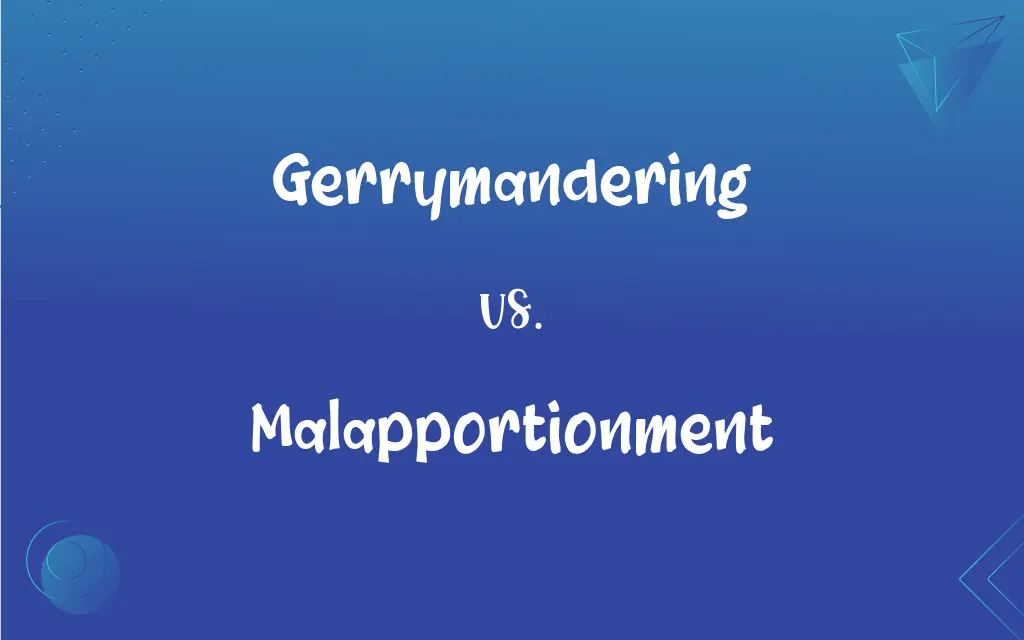Gerrymandering vs. Malapportionment: What's the Difference?
By Aimie Carlson & Harlon Moss || Updated on May 20, 2024
Gerrymandering manipulates electoral district boundaries to favor a party, while malapportionment results in unequal representation due to population distribution.

Key Differences
Gerrymandering involves the deliberate manipulation of electoral district boundaries to create a political advantage for a particular party or group. This is done by concentrating the opposing party's voters into a few districts or spreading them across many districts to dilute their influence. Malapportionment, on the other hand, occurs when electoral districts have significantly different population sizes, leading to unequal representation.
Gerrymandering often exploits specific demographics to secure electoral advantages, typically involving strategic redistricting after census data is collected. Malapportionment, by contrast, may stem from a lack of timely redistricting rather than intentional manipulation.
While gerrymandering is often a deliberate act by those in power to maintain or increase their political strength, malapportionment can occur unintentionally due to administrative neglect or bureaucratic inertia. Gerrymandering seeks to engineer electoral outcomes, whereas malapportionment reflects a failure to adjust to population realities, leading to unequal voter influence.
Both gerrymandering and malapportionment ultimately impact democratic fairness, but they do so through different mechanisms. Gerrymandering directly manipulates voter influence through boundary changes, whereas malapportionment results from uneven voter distribution without adjustments to district lines. Addressing these issues requires different approaches: legal reforms and judicial oversight for gerrymandering, and regular redistricting practices for malapportionment.
Comparison Chart
Definition
Manipulation of electoral district boundaries
Unequal representation due to population distribution
ADVERTISEMENT
Intentionality
Deliberate and strategic
Often unintentional or due to neglect
Result
Favoritism towards a political party
Imbalance in voter influence
Mechanism
Redrawing boundaries
Disproportionate district sizes
Impact on Democracy
Undermines fair representation
Violates "one person, one vote" principle
Gerrymandering and Malapportionment Definitions
Gerrymandering
Manipulation of electoral district boundaries for political gain.
The party used gerrymandering to secure more seats.
ADVERTISEMENT
Malapportionment
Unequal representation due to uneven district populations.
Malapportionment left rural voters overrepresented.
Gerrymandering
Drawing districts to favor a particular party.
The map showed clear gerrymandering to favor incumbents.
Malapportionment
Disproportionate allocation of legislative seats.
The state's malapportionment issue sparked legal challenges.
Gerrymandering
Creating irregularly shaped districts to influence elections.
The gerrymandered district looked like a snake.
Malapportionment
Lack of district boundary updates to reflect population changes.
Decades of malapportionment resulted from outdated district maps.
Gerrymandering
Adjusting boundaries to enhance electoral prospects.
They resorted to gerrymandering after losing the last election.
Malapportionment
Representation disparity arising from demographic changes.
Malapportionment gave some districts more legislative power.
Gerrymandering
Political strategy to dilute opposition votes.
Gerrymandering diluted the urban vote by merging it with rural areas.
Malapportionment
Imbalanced voter influence due to population shifts.
Urban areas suffered from malapportionment, reducing their impact.
Gerrymandering
To divide (a geographic area) into voting districts in a way that gives one party an unfair advantage in elections.
Malapportionment
Characterized by an inappropriate or unfair proportional distribution of representatives to a legislative body.
Gerrymandering
The act, process, or an instance of gerrymandering.
Malapportionment
(politics) Any system where one group has significantly more influence than another, such as when voting districts are unevenly spread out across a population (compare gerrymandering).
Gerrymandering
A district or configuration of districts whose boundaries are very irregular due to gerrymandering.
Gerrymandering
(politics) The practice of redrawing electoral districts to gain an electoral advantage for a political party.
Gerrymandering
Present participle of gerrymander
FAQs
What is gerrymandering?
Gerrymandering is the manipulation of electoral district boundaries to favor a particular political party.
How does malapportionment impact democracy?
Malapportionment undermines democratic principles by giving unequal weight to votes from different districts.
What is malapportionment?
Malapportionment occurs when electoral districts have unequal populations, leading to disproportionate representation.
Can both gerrymandering and malapportionment occur in the same region?
Yes, a region can experience both gerrymandering and malapportionment simultaneously.
Is malapportionment a global issue?
Yes, malapportionment can occur in any representative democracy with changing populations.
Is gerrymandering legal?
The legality of gerrymandering varies; some forms are permissible, but extreme cases can be challenged in court.
What causes malapportionment?
Malapportionment is caused by outdated district boundaries and failure to adjust to population changes.
How does gerrymandering affect elections?
Gerrymandering skews election results by concentrating or dispersing certain voters to benefit a political party.
What is the main goal of gerrymandering?
The primary goal of gerrymandering is to secure electoral advantages for a specific party or group.
How does malapportionment affect rural and urban areas?
Malapportionment often results in rural areas being overrepresented and urban areas underrepresented.
Can malapportionment be intentional?
While often unintentional, malapportionment can be exacerbated by neglecting regular redistricting.
How can gerrymandering be prevented?
Independent redistricting commissions and judicial oversight can help prevent gerrymandering.
Does gerrymandering always result in oddly shaped districts?
Not always, but many gerrymandered districts have irregular shapes designed to achieve specific electoral outcomes.
How do voters get involved in preventing gerrymandering and malapportionment?
Voters can advocate for fair redistricting practices, support independent commissions, and participate in legal challenges.
Who benefits from gerrymandering?
Typically, the political party in control of the redistricting process benefits from gerrymandering.
Can court rulings address gerrymandering?
Yes, courts can and have ruled against unconstitutional gerrymandering practices.
What role does the census play in these issues?
The census provides population data essential for redistricting to prevent malapportionment and identify gerrymandering.
How can malapportionment be corrected?
Regularly updating district boundaries to reflect population shifts can correct malapportionment.
What is the "one person, one vote" principle?
It is the principle that each person's vote should have equal weight in an election.
Are there any famous cases of gerrymandering?
Yes, many states in the U.S. have notable gerrymandering cases, such as North Carolina and Pennsylvania.
About Author
Written by
Aimie CarlsonAimie Carlson, holding a master's degree in English literature, is a fervent English language enthusiast. She lends her writing talents to Difference Wiki, a prominent website that specializes in comparisons, offering readers insightful analyses that both captivate and inform.
Co-written by
Harlon MossHarlon is a seasoned quality moderator and accomplished content writer for Difference Wiki. An alumnus of the prestigious University of California, he earned his degree in Computer Science. Leveraging his academic background, Harlon brings a meticulous and informed perspective to his work, ensuring content accuracy and excellence.































































